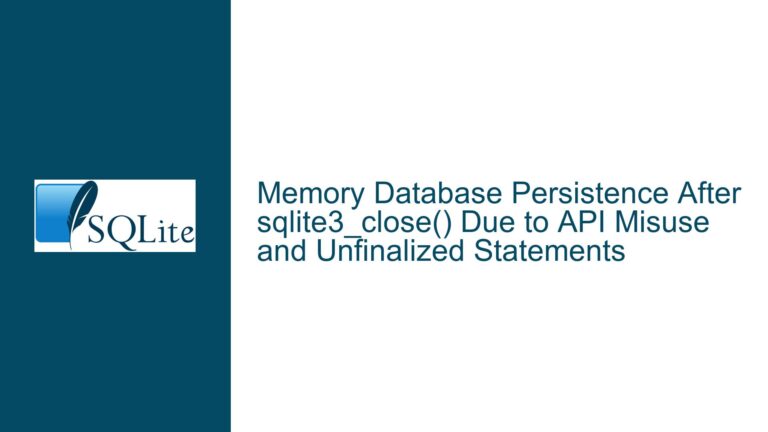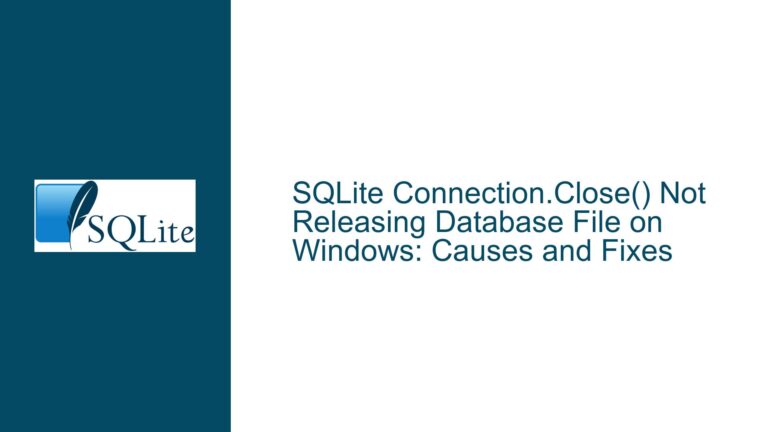Integrating SQLite WASM with Browser Extension Service Worker Storage
Challenge: Asynchronous Storage APIs in Browser Extension Service Workers Block SQLite WASM KVVFS Integration
Issue Overview: Service Worker Limitations and SQLite’s Synchronous Storage Requirements
Browser extensions operate in a unique environment with distinct components: content scripts, popup pages, and background service workers. Service workers, responsible for background tasks, lack access to traditional web APIs like Window.localStorage but provide alternatives such as browser.storage.local (Chrome: chrome.storage.local). These storage mechanisms are functionally similar to localStorage but differ critically in their asynchronous design, using methods like get()/set() instead of synchronous getItem()/setItem().
SQLite’s WASM builds rely on synchronous key-value virtual file systems (kvvfs) for persistent storage. The default kvvfs implementations (localStorage, sessionStorage) are tightly coupled to synchronous APIs. Service workers, however, cannot access these APIs, necessitating the use of asynchronous alternatives. This creates a fundamental incompatibility: SQLite’s internal operations assume synchronous storage access, while browser extension service workers enforce asynchronous storage interactions.
The problem is compounded by the absence of the Origin Private File System (OPFS) in service workers. OPFS, which provides synchronous file access in dedicated workers via the FileSystemSyncAccessHandle API, is unavailable in service workers due to missing browser APIs. Even if OPFS were accessible, service workers lack the threading model required to integrate OPFS with SQLite’s WASM build. This leaves developers with a gap: persistent storage options for SQLite in service workers are either asynchronous (and thus unusable) or entirely absent.
Root Cause: Asynchronous Storage APIs and SQLite’s Synchronous Architecture
1. Synchronous vs. Asynchronous Storage Access in SQLite WASM
SQLite’s WASM bindings are designed around synchronous I/O operations. When a SQL query executes, it expects immediate access to storage. This is non-negotiable for transactional consistency and performance. The kvvfs layer maps SQLite’s file operations to key-value storage calls (e.g., localStorage.setItem()). If these calls are asynchronous (returning promises), SQLite cannot wait for their resolution without blocking the execution thread, leading to corrupted transactions or runtime errors.
2. Browser Extension Environment Constraints
Service workers in browser extensions are event-driven scripts with no DOM access. They prioritize non-blocking operations, hence the async design of browser.storage.local. For example:
// Async API in service workers
browser.storage.local.get("key", (result) => { ... });
Attempting to wrap this in a synchronous interface would require blocking the event loop until the promise resolves, which is prohibited in JavaScript’s single-threaded runtime. While Atomics.wait() can simulate synchronous behavior in dedicated workers, it is disallowed in service workers and main threads due to security and performance risks.
3. OPFS Unavailability in Service Workers
The Origin Private File System (OPFS) offers a synchronous API via FileSystemSyncAccessHandle, but it is restricted to dedicated workers (not service workers). Service workers lack the FileSystemHandle APIs entirely, making OPFS unusable even if the SQLite WASM build supports it. This limitation stems from browser vendors’ security policies, which restrict file system access in service workers to prevent blocking during critical network proxy tasks.
4. Toolchain Limitations: Emscripten and Asyncify
The SQLite WASM build avoids dependencies on Emscripten’s Asyncify tool, which transforms asynchronous JavaScript operations into synchronous WASM-compatible code. Asyncify introduces overhead (larger binary sizes, slower execution) and complicates error handling, especially for promise rejections. Without Asyncify, there is no mechanism to bridge SQLite’s synchronous expectations with the asynchronous browser.storage.local APIs.
Resolution: Workarounds, Alternative VFS Strategies, and Future Prospects
1. Leverage Dedicated Workers via Extension Service Workers
If the extension’s architecture permits, spawn a dedicated worker from the service worker. Dedicated workers can use OPFS if the browser supports it, enabling SQLite to operate with a synchronous VFS. While service workers cannot directly access OPFS, they can delegate storage tasks to a dedicated worker via postMessage():
// In service worker
const worker = new Worker('dedicated-worker.js');
worker.postMessage({ type: 'query', sql: 'SELECT * FROM table' });
// In dedicated worker
self.onmessage = async (event) => {
const db = await sqlite3.open({ vfs: 'opfs' });
const result = await db.exec(event.data.sql);
self.postMessage(result);
};
This approach requires browser support for spawning workers from service workers, which is experimental but under active discussion in the WebExtensions Community Group.
2. Adopt Third-Party SQLite WASM Builds with Asyncify
Projects like wa-sqlite and cr-sqlite utilize Emscripten’s Asyncify to wrap asynchronous storage APIs in synchronous interfaces. These builds accept performance trade-offs (10-20% slower execution, larger WASM binaries) to enable compatibility with browser.storage.local:
import { Database } from '@vlcn.io/crsqlite';
// Async setup, synchronous queries
const db = await Database.open('mydb');
db.execSync('CREATE TABLE IF NOT EXISTS t (a, b)');
Trade-offs:
- Increased memory usage due to Asyncify stack unwinding.
- Complex error handling for rejected promises.
- Compatibility issues with non-Emscripten toolchains.
3. Implement a Custom Asynchronous VFS Proxy
Develop a lightweight VFS that queues SQLite operations and processes them asynchronously. This requires modifying SQLite’s WASM build to defer execution until storage operations complete:
class AsyncVFS {
constructor(storage) {
this.storage = storage;
this.queue = [];
}
async xWrite(fileId, buffer, offset) {
await this.storage.set({ [fileId]: buffer });
}
async xRead(fileId, buffer, offset) {
const data = await this.storage.get(fileId);
buffer.set(data);
}
}
// Inject custom VFS into SQLite
sqlite3.vfs_register(new AsyncVFS(browser.storage.local));
Challenges:
- Transactions may fail if interrupted by asynchronous delays.
- Complex concurrency management for overlapping reads/writes.
- Requires forking the SQLite WASM codebase.
4. Advocate for Synchronous Storage APIs in Browser Extensions
Engage with browser vendors to propose synchronous storage APIs for service workers, specifically for extensions. For example, a browser.storage.sync API with a synchronous mode when the unlimitedStorage permission is granted. This would mirror the localStorage API but with extension-compatible security policies.
5. Monitor Emerging Standards: JSPI and Web Locks
The JavaScript Promise Integration (JSPI) proposal aims to expose synchronous interfaces to asynchronous WASM functions. If adopted, it could enable SQLite to use browser.storage.local without Asyncify:
// Hypothetical JSPI-enabled C function
EM_JS_Promise(int, storage_get, (const char* key), {
const value = await browser.storage.local.get(key);
return value;
});
Current Limitations:
- No standardized error handling for promise rejections.
- Requires deep integration with Emscripten, which SQLite avoids.
6. Fallback to Memory VFS with Periodic Checkpoints
If persistence is optional, use SQLite’s memory VFS and periodically serialize the database to browser.storage.local:
const db = new sqlite3.oo1.DB(':memory:');
db.exec('CREATE TABLE t (a, b)');
// Save to storage every 5 minutes
setInterval(async () => {
const binary = db.export();
await browser.storage.local.set({ db: binary });
}, 300_000);
// Load from storage on startup
const { db: binary } = await browser.storage.local.get('db');
if (binary) db.import(binary);
Risks:
- Data loss if the extension crashes before a checkpoint.
- Limited storage capacity for large databases.
Conclusion
The core challenge—synchronous storage access in asynchronous environments—arises from conflicting design philosophies between SQLite’s WASM architecture and browser extension service worker constraints. Short-term solutions involve architectural workarounds (dedicated workers, third-party builds), while long-term fixes depend on browser API evolution (JSPI, synchronous storage permissions). Developers must weigh trade-offs between persistence, performance, and complexity when integrating SQLite into browser extensions.






